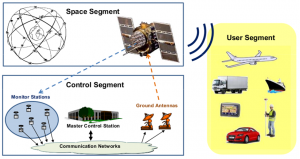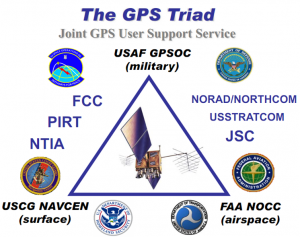If you wish to contribute or participate in the discussions about articles you are invited to contact the Editor
GPS Architecture: Difference between revisions
mNo edit summary |
(First upload) |
||
| Line 7: | Line 7: | ||
|Logo=GMV | |Logo=GMV | ||
}} | }} | ||
The GPS Space | The GPS architecture is divided into three major segments: a [[GPS Space Segment]] (SS), a [[GPS Ground Segment]] (CS), and a [[GPS User Segment]] (US). | ||
==[[GPS Space Segment|The Space Segment]]== | |||
The main functions of the [[GPS Space Segment]] are to generate and transmit code and carrier phase signals with a specific signal structure, and to store and retransmit the navigation message sent by the Control Segment. These transmissions are controlled by highly stable atomic clocks on board the satellites. | |||
The GPS Space Segment is formed by a satellite constellation with enough satellites to ensure that the users will have, at least, 4 simultaneous satellites in view from any point at the Earth surface at any time. | |||
The | ==[[GPS Ground Segment|The Ground Segment]]== | ||
The [[GPS Ground Segment]] (also referred to as Control Segment) is the responsible for the proper operation of the GPS system. | |||
The GPS Control Segment is composed by a network of Monitor Stations (MS), a Master Control Station (MCS) and the Ground Antennas (GA). | |||
The Master Control Station (MCS) processes the measurements received by the Monitor Stations (MS) to estimate satellite orbits (ephemerides) and clock errors, among other parameters, and to generate the navigation message. These corrections and the navigation message are uploaded to the satellites through the Ground Antennas, which are co-located in four of the Monitor stations (Ascension Island, Cape Canaveral, Diego Garcia, and Kwajalein). | |||
The GPS | ==[[GPS User Segment|The User Segment]]== | ||
The | The [[GPS User Segment]] is composed by GPS receivers. Their main function is to receive GPS signals, determine pseudoranges (and other observables), and solve the navigation equations in order to obtain their coordinates and provide a very accurate time. Please refer to [[:Category:Receivers|GNSS Receivers]]. | ||
==Boundaries Among Segments== | |||
[[File:GPS_architecture.png|GPS segments|right|thumb|300px]] | |||
The communication boundaries between these three segments are documented in the Interface Control Documents (ICDs):<ref>[http://www.gps.gov/technical/icwg/ GPS Interface Control Documents ICDs</ref> | |||
* IS-GPS-200:<ref name=" IS-GPS-200-E "> Interface Specification IS-GPS-200, Revision E</ref> defines the requirements related to the interface between the Space Segment (SS) of the Global Positioning System (GPS) and the navigation User Segment (US) of the GPS for radio frequency (RF) link 1 (L1) and link 2 (L2). | |||
* IS-GPS-705):<ref name=" IS-GPS-705A "> Interface Specification IS-GPS-705A</ref> defines the requirements related to the interface between the Space Segment (SS) of the Global Positioning System (GPS) and the navigation User Segment (US) of the GPS for radio frequency (RF) link 5 (L5). | |||
* ICD-GPS-870:<ref name=" ICD-GPS-870 "> Interface Specification ICD-GPS-870 </ref> This ICD defines the interfaces between the Operational Control Segment and the GPS users. The files provided by the Control Segment to the users are the Almanacs, Operational Advisories (OAs), Anti-Spoofing (A-S) status, and the Notice Advisory to Navstar Users (NANUs). | |||
[[File:GPS_triad.png|right|thumb|300px]] | |||
Besides these interface documents, the following three centers (privately referred as the Big Three or the GPS triad) provide a interface between GPS and any user, civilian or military:<ref>[http://www.pnt.gov/public/docs/2008/idmpublicsummary.pdf U. S. Positioning, Navigation, and Timing Interference Detection and Mitigation Plan Summary]</ref> | |||
* '''U.S. Strategic Command GPS Operations Center (GPSOC)''': is the Department of Defense (DoD) primary point of contact for information regarding status of GPS Precise Positioning Service (PPS) and GPS Standard Positioning Service (SPS). The GPSOC is in charge of responding to inquiries and providing information regarding the GPS constellation and the existence of space segment anomalies or issues that could result in GPS outages worldwide. | |||
* '''U.S. Coast Guard (USCG) Navigation Center (NAVCEN)''': is the primary interface to all civil non-aviation users of GPS. It provides capabilities for question or issue resolution regarding GPS anomalies and interference reporting, to support maritime and land users with prioritized approach for safety-of-life applications. | |||
* '''Federal Aviation Administration (FAA) National Operations Control Center (NOCC)''': Responsible for the management and resolution of all aviation reported interference. Due to the safety-of-life considerations, the FAA has well-defined procedures for dealing with the notification and coordination of any interference reports from aviation users, which includes the processing of National Airspace System (NAS) interference reports and specifically, GPS interference reports. | |||
==Notes== | |||
<references group="footnotes"/> | |||
==References== | |||
<references/> | |||
[[Category:GPS]] | [[Category:GPS]] | ||
Revision as of 13:55, 31 March 2011
| GPS | |
|---|---|
| Title | GPS Architecture |
| Author(s) | GMV |
| Level | Basic |
| Year of Publication | 2011 |
The GPS architecture is divided into three major segments: a GPS Space Segment (SS), a GPS Ground Segment (CS), and a GPS User Segment (US).
The Space Segment
The main functions of the GPS Space Segment are to generate and transmit code and carrier phase signals with a specific signal structure, and to store and retransmit the navigation message sent by the Control Segment. These transmissions are controlled by highly stable atomic clocks on board the satellites.
The GPS Space Segment is formed by a satellite constellation with enough satellites to ensure that the users will have, at least, 4 simultaneous satellites in view from any point at the Earth surface at any time.
The Ground Segment
The GPS Ground Segment (also referred to as Control Segment) is the responsible for the proper operation of the GPS system.
The GPS Control Segment is composed by a network of Monitor Stations (MS), a Master Control Station (MCS) and the Ground Antennas (GA).
The Master Control Station (MCS) processes the measurements received by the Monitor Stations (MS) to estimate satellite orbits (ephemerides) and clock errors, among other parameters, and to generate the navigation message. These corrections and the navigation message are uploaded to the satellites through the Ground Antennas, which are co-located in four of the Monitor stations (Ascension Island, Cape Canaveral, Diego Garcia, and Kwajalein).
The User Segment
The GPS User Segment is composed by GPS receivers. Their main function is to receive GPS signals, determine pseudoranges (and other observables), and solve the navigation equations in order to obtain their coordinates and provide a very accurate time. Please refer to GNSS Receivers.
Boundaries Among Segments
The communication boundaries between these three segments are documented in the Interface Control Documents (ICDs):[1]
- IS-GPS-200:[2] defines the requirements related to the interface between the Space Segment (SS) of the Global Positioning System (GPS) and the navigation User Segment (US) of the GPS for radio frequency (RF) link 1 (L1) and link 2 (L2).
- IS-GPS-705):[3] defines the requirements related to the interface between the Space Segment (SS) of the Global Positioning System (GPS) and the navigation User Segment (US) of the GPS for radio frequency (RF) link 5 (L5).
- ICD-GPS-870:[4] This ICD defines the interfaces between the Operational Control Segment and the GPS users. The files provided by the Control Segment to the users are the Almanacs, Operational Advisories (OAs), Anti-Spoofing (A-S) status, and the Notice Advisory to Navstar Users (NANUs).
Besides these interface documents, the following three centers (privately referred as the Big Three or the GPS triad) provide a interface between GPS and any user, civilian or military:[5]
- U.S. Strategic Command GPS Operations Center (GPSOC): is the Department of Defense (DoD) primary point of contact for information regarding status of GPS Precise Positioning Service (PPS) and GPS Standard Positioning Service (SPS). The GPSOC is in charge of responding to inquiries and providing information regarding the GPS constellation and the existence of space segment anomalies or issues that could result in GPS outages worldwide.
- U.S. Coast Guard (USCG) Navigation Center (NAVCEN): is the primary interface to all civil non-aviation users of GPS. It provides capabilities for question or issue resolution regarding GPS anomalies and interference reporting, to support maritime and land users with prioritized approach for safety-of-life applications.
- Federal Aviation Administration (FAA) National Operations Control Center (NOCC): Responsible for the management and resolution of all aviation reported interference. Due to the safety-of-life considerations, the FAA has well-defined procedures for dealing with the notification and coordination of any interference reports from aviation users, which includes the processing of National Airspace System (NAS) interference reports and specifically, GPS interference reports.
Notes
References
- ^ [http://www.gps.gov/technical/icwg/ GPS Interface Control Documents ICDs
- ^ Interface Specification IS-GPS-200, Revision E
- ^ Interface Specification IS-GPS-705A
- ^ Interface Specification ICD-GPS-870
- ^ U. S. Positioning, Navigation, and Timing Interference Detection and Mitigation Plan Summary


